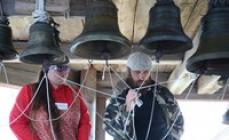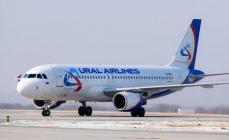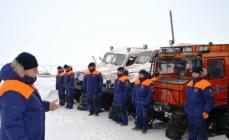The Black Sea ended a few weeks ago, in the near future will be announced the official version of the crash. This was stated by the Minister of Defense, answering the question of Senator Lyudmila Narusova during the government hour at.
“We ourselves are extremely interested in this and approach this with such special scrupulousness. Just a few weeks ago, we completed work there to find all the necessary details, ”the head of the military department quotes.
Shoigu emphasized that the Ministry of Defense “has 99% confidence” that the final version of the reasons for the crash of the liner has been established, reports.
According to Gazeta.Ru in late April, specialists involved in the investigation of the Tu-154 accident concluded that the plane fell into the water due to overload. When the plane took off from the airport in Adler, its take-off weight after refueling was approximately 110 tons instead of the standard 98 tons.
In this regard, the problems with the aircraft began during takeoff. The liner hardly took to the air: its separation from the runway occurred only at the 37th second after the start of the take-off, and the climb was 10 m / s instead of the usual 12-15 m / s.
Specialists also came to the conclusion that the Tu-154 crew, together with the commander, an experienced pilot Roman the most likely, knew nothing about the overload of the aircraft.
If Volkov was aware that the take-off weight of the aircraft exceeds the standard by more than 10 tons, he would either refuse to fly or take off taking into account the strong overload of the liner, experts calculated.
Later, the version of the plane crash, according to which the plane crash occurred due to its overload, was denied.
“The statement appeared in the press about the overload of the Tu-154 aircraft, which allegedly caused a catastrophe over the Black Sea, does not correspond to the established factual circumstances and criminal case materials,” said the official representative of the department Svetlana Petrenko.
Specialists also came to the conclusion that the dark time of the day in which he was flying played a role in the crash:
the crew did not have a visual representation that very little remained to the water surface. About this in March, Kommersant also wrote.
Experts interviewed by the newspaper suggested that Volkov’s disorientation in space could be the cause of the crash. The crew commander gained altitude in the dark and did not visually control the position of the aircraft, since he did not see any landmarks in front of him, including the horizon. The stars that shone in the sky and at the same time reflected in the water could also disorient the pilot.
As a result of this, the overload that arose during acceleration of the aircraft could create the illusion of climb for the crew commander, although the liner, on the contrary, was decreasing at that time, the source said.
The Tu-154 plane of the Russian Ministry of Defense, flying from Sochi to Syrian Latakia, crashed over the Black Sea early on December 25.
His last flight lasted a total of 74 seconds.
There were 92 people on board, including the head of the Fair Aid Foundation, Elizaveta Glinka (Doctor Lisa), the crew of Channel One, and also the main staff of the Alexandrov ensemble, who flew to Syria to congratulate the Russian military on New Year. They all died.
Experts interviewed by Kommersant also noticed that the flight to Syria was extended for the Tu-154 crew for a whole day, which could affect its physical condition.
First, the airliner waited for several hours to fly out of Moscow, and then, due to bad weather conditions, made an emergency landing in the poorly-known crew of the Adler airport instead of the planned Mozdok. As a result, the flight turned from day to night. His delay could, among other things, provoke an exacerbation of some chronic diseases in the crew or put him in a state of stress, experts say.
Late on Wednesday, May 31, the Ministry of Defense announced the completion of the investigation of the TU-154 plane crash, which did not reach Syria last December. Then, we recall, 92 people died: the artists of the ensemble named after Alexandrov, Dr. Lisa, the head of the culture department of the Ministry of Defense Anton Gubankov, military officials. Now the culprit is named - this is a dead pilot. However, more complete results of the investigation were made public not at the filing of the ministry, but a day earlier. A blogger under the nickname Podpolkovnikvvs posted on LJ scans of the commission’s report, which clarified the causes of the tragedy. When the ministry spoke about its version and the wording coincided with the phrases from the “leak”, it became clear that the “leak” was not fake. And that the ministry said far from all that was to be said.
It follows from a report published on the Web that crew fatigue led to the accident. This fatigue has accumulated due to monstrous violations in the military unit. “Mess,” Magomed Tolboev, the test pilot, shortly appreciated this, after reading the papers. Aircraft designer Mark Solonin checked the commission report with a calculator and found even more interesting details.
Version one: mess
A week ago, Defense Minister Sergei Shoigu in the Federation Council announced that the cause of the crash would be known right away, it remains only to clarify the details. “There is 99% confidence that we already have a version of the causes of this disaster,” he said (quote from RIA Novosti). “I think that in the near future we will probably receive the latest data and announce the final version.”
By this time, the conclusion of the commission to investigate the crash had already been ready for three weeks. It is dated May 4, 2017, on that day he was sent to the chief of the flight safety service, Lieutenant General Bainetov. The paper is marked "Particleboard" - "for official use." It is not known what “official version” Shoigu planned to “voice” and when he was going to do it, if not for the leak.
As stated in the document, the Tu-154B-2 aircraft with tail number RA-85572 took off from the Chkalovsky airfield near Moscow at twenty-two nights on December 25th. Two hours later, he made a “technical landing at the airport in Sochi” for “refueling”. At the same time, "no passengers were landing and disembarking, no loading was carried out."
Having refueled safely, the plane was preparing to head for Syrian Latakia, so that the artists of the Alexandrov ensemble gave a concert for the Russian military, and Dr. Lisa handed the humanitarian aid. This was the official purpose of the flight. But as soon as the board stood on the runway, a "special situation" arose, as the report says.
The aircraft commander (FAC) suddenly began to "have difficulty determining his location on the airfield." At the seventh second of the run, he "emotionally began to ask the crew about the take-off course." Further, "conducting unspecified radio exchange using profanity and increasing emotional stress in the crew ... led to the missed PIC control of significant take-off parameters, distracting crew members from their performance of functional duties."
The report describes in detail the actions of the pilot during the 70 seconds of flight. The navigator shouted “Wow, my! ..”, “Dangerous land” burned on the board, the plane tipped over - and an inscription about it lit up, all crew members “informed the FAC” about the problem, the siren howled about a dangerous approach to the ground. But the pilot took actions, which in the report are called inadequate to “change of flight parameters”. The last words in the “black box” record are “Commander, we are falling!” The plane crashed on the water.
“The commander made absolutely chaotic movements, not imagining the behavior of the aircraft,” described the test pilot, Russian hero Magomed Tolboev, described in the document’s actions. “He completely lost control of the plane.” I did everything out of place, in the wrong direction, it is not clear what signals I reacted to. And with each movement, he exacerbated the situation. Apparently, no one in the carriage could change anything. This is called a crew inconsistency. This is not a working crew. That is, a complete loss of control on the part of the commander both over the aircraft and over the crew.
It is precisely this conclusion about the causes of the crash that the commission makes: "violation of the spatial orientation (situational awareness) of the aircraft commander, which led to his erroneous actions." The Ministry of Defense cites this part of the conclusion, but is silent about the continuation. Among the reasons for this state of the pilot, the commission names “excessive psychological stress caused by a combination of a number of situational psychological stress factors against the background of natural emotional and physiological fatigue”. And then what is listed is why Air Force Major Volkov, Lieutenant Colonel Petukhov, Captain Mamonov, Major Tregubov, Senior Lieutenant Parikkamerov and Senior Sergeant Sushkov could be under the influence of stress and in such a state of fatigue.
The document was not leaked to the Network. But even in the part that turned out to be available, the list of all kinds of violations in the military unit from which the crew was recruited takes two pages. The crew did not undergo preliminary training. Nobody reported on the tasks for the upcoming flight to the commander, Major Volkov. There was no training on simulators either. And this was not only the last flight. “Major Volkov repeatedly performed flights and flights without preliminary preparation and control of readiness for them,” the commission notes and points out five such cases. A medical examination of the commander at the airport was conducted more than two hours before departure.
Magomed Tolboev, as already mentioned, noted that the crew was not working. But he couldn’t work together, because he was assembled, as the report says, “from various air squadrons”. The navigator did not have access to international flights. And, perhaps, at the last moment, he generally found out where to fly, because for him, “a control flight was not planned.” The crew was not notified in advance about the upcoming change in the route, that is, apparently, about refueling in Sochi.
All this, Magomed Tolboev agrees with the commission, has become the “combination of stress factors”. In the end, this led to the fact that the plane was operated by a failed crew, consisting of deadly tired people. Able from fatigue to really lose the "spatial orientation".
“There was a complete mess in this military unit,” Tolboev says. - And here everything is clear: the crew was just tired. Tired and uncontrollable. Squadron commander, flight commander, regiment commander, base — and so on — are responsible for organizing flights. And all these persons committed criminal negligence, allowing a tired crew to fly.
Another thing, the pilot adds, is that the aircraft commander bears full responsibility for the flight itself, and if Volkov felt that he was not capable of landing at the helm, he should have refused. But Volkov wore only major epaulets. If he was ordered by a senior in rank, he could not refuse.
“Because of precisely such circumstances, a Polish plane died in 2010,” adds Magomed Tolboev.
Recall that in July 2011, the Polish Ministry of Defense announced the results of the work of the commission, which investigated the crash of Tu-154 by President Kaczynski in April 2010. It turned out that the level of training of pilots in the Polish elite special regiment "threatened the safety" of the first persons. Pilots were overloaded with tasks and did not have time to rest, experienced pilots quit, there weren’t enough training for new pilots, there weren’t enough crews, they were put together from different squadrons, and those who didn’t have the necessary clearance were put on international flights. The commander led the crew for the first time in his life, before that he flew as a co-pilot. Psychologically, he is not used to making decisions, but to obey. The weather conditions in Smolensk, where he was to land the presidential board, were such that several planes went to other airfields. This young commander tried to do the same. But the general of the Polish Air Force came into his cabin and conveyed the order of President Kaczynski: we are late, so you sit in Smolensk. Killed 96 people, including the president himself, his wife and most of the elite of the state.
The disaster in Sochi, as described in the report of the Russian commission, repeats the crash of the Polish side with frightening accuracy.
“Only the numbers that were shown to us in this report do not hold water,” adds Mark Solonin, an aircraft engineer, historian and publicist.
Version two: linden
Even more strange, he finds the numbers regarding flight parameters. They occupy one and a half pages in the document, but they contradict, he believes, to each other, and existing versions of the crash, and the laws of physics. And they do not explain the main thing: why, when an airplane fell into the water, the bodies of passengers were torn into hundreds of fragments.
“I just took a pencil and a calculator and found a lot of interesting things,” says Solonin.
The plane collided with water, as stated in a published document, at the 73rd second from the start of movement or at the 39th after taking off the ground. At this point, the pitch angle is minus 4 degrees.
“The pitch, to put it more simply, shows if the nose of the plane is raised up or down,” Solonin explains. - Minus four degrees is such a small pitch that from the side you would think that the plane flies almost horizontally. That is, the plane is very hollow, literally tangentially rubbed against the water surface. It does not look like a fall, but a landing on the water. Aviation knows dozens of cases of landing on water. In many of them, people remained alive. And certainly when landing on water the bodies did not turn into hundreds of fragments, as in this case.
The next parameter Mark Solonin pays attention to is the vertical speed (fall speed): 30 meters per second.
“It's 108 kilometers per hour,” he explains. - If a car crashes into a concrete wall at such a speed, people, of course, die, but there is no talk of “fragments of bodies”. An exceptionally durable aircraft is not a tin of a modern car, and water is not a concrete wall. In 2009, there was such a case: an AirFrance plane crashed into the ocean, it collapsed, but people's bodies got out of the water quite suitable for identification. And he entered the water with a pitch angle of 30 degrees, that is, he dived specifically. And fell from a height of 11 kilometers and collided with water at a vertical speed of 200 kilometers per hour.
The third oddity is the point indicated in the document at which the plane collided with water: at a distance of 2760 meters from the end of the runway.
“And the entire flight, judging by the document, lasted 39 seconds after taking off the ground,” continues Solonin. - We perform simple arithmetic operations and we obtain that the average flight speed was 255 kilometers per hour. This is absolutely not true. The same document indicates that he took off at a speed of 300 km / h, and fell into the water at a speed of 540 kilometers per hour. This means that he had to fly a much greater distance and fall at a completely different point by the time of the fall. Or the flight lasted longer than 39 seconds, the plane managed to retire from the coast, turn around and approach the coast. Such a trajectory was made public immediately after the disaster.
Another chain of arithmetic operations is based on data on the speed of the aircraft at different seconds of movement. And you can see: up to a certain point, the acceleration with which the aircraft was accelerating decreased in full accordance with the laws of physics. But 10 seconds before the end, the picture in the report changes dramatically.
“In a mysterious way, from 63rd second to 73rd speed increased sharply, and in the last 3 seconds, the acceleration was just fantastic,” continues Mark Solonin. - In order not to bore you with calculations, I’ll say that a fourth-generation fighter in the configuration of air combat can have such an energetic acceleration rate. MIG-29 can accelerate like that, but Tu-154 - never.
Shortly after the crash, allegedly transcripts of “black boxes” appeared in the press, where in the last seconds of the flight a cry was heard: “Flaps!”. Then for a long time the topic was discussed that the commander had mixed up and removed the flaps instead of the chassis. But according to the numbers in the report, Solonin notes, it turns out that everything was in order with the flaps and the chassis.
“But there are a lot of photographs, and they show that the chassis is simply mechanically torn to shreds,” the engineer recalls. - That is, the photographs show that the plane met with the water surface when the landing gears were released. If you look at the numbers in the document, it is completely incomprehensible how these destruction occurred.
If we summarize the results of the analysis of all the data, as they are presented in the report, it turns out, according to Solonin, a fantastic picture.
“The crew took off normally, removed the chassis, removed the flaps,” he translates the language of numbers. - Then the commander went crazy, began to perform incomprehensible actions, committed them for 10 seconds, while his board was on and the alarm was sound, but he drove the plane into the water.
Although, after all, even such an episode, adds Solonin, was in the history of aviation: in 1982, a Japanese pilot sent a plane into the water in a fit of madness at a speed of 240 kilometers per hour.
“There were 174 people on board,” says Solonin. - Of these, 150 people survived.
“At 99 percent, I got the feeling that these numbers are fake,” Solonin said. - Here, either a large amount of lies was added, or a large amount of truth was removed.
Version Three: Explosion
Such destruction of human bodies could be explained by an explosion, but there is no known explosion in the air.
“The reason the plane crashed remained incomprehensible to me,” says Mark Solonin. “But after a fall, or maybe because of the fall, an explosion could occur. Perhaps something detonated in the very cargo bay, where supposedly only 150 kilograms of cargo lay. Something that could lie there besides 150 kilograms of cargo.
We will repeat that the plane flew into belligerent Syria with artists and humanitarian aid on board. In some sources, however, some kind of “military equipment” was mentioned.
“The version of the explosion after the fall is indirectly confirmed by fire marks on some fragments and curved parts of the cargo compartment floor,” adds Mark Solonin. “The plane was probably already under water.” The fuselage was squeezed on all sides by thousands of tons of water that held the walls of the hull. Under such conditions, the effect of an explosion inside a confined space could be especially strong, and such strength would be enough to destroy soft human bodies.
Irina Tumakova, Fontanka.ru
A week ago, on May 24, the Minister of Defense announced that the investigation of the Tu-154 crash over the Black Sea was almost completed and will be published shortly. Instead, scans of a document appeared in an anonymous Telegram channel “Captain Vrungel”, whose author certifies himself as an insider in the life of the armed forces, containing a brief summary of the course and reasons for the events that took place on the morning of December 25, 2016 in Sochi.
What is the status of leaked?
The document is a certificate drawn up at the beginning of May 2017 based on the materials of the investigation that passed through the apparatus of the head of the Aviation Safety Service of the Armed Forces, Sergey Bainetov.
There can be no complete certainty that we have before us truly official investigation materials. There are no “caps” and signatures on the documents, on which it would be possible to draw conclusions about the status of the document, its addressee and correct execution.
However, sources close to, avoiding speculation about the authenticity of the leakage materials, note that the document on the style and nature of the presentation "is exactly the same as it is written in similar situations."
Already after the delivery of the material, it appeared that the Ministry of Defense confirmed the causes of the disaster, as set out in the document.
Moreover, the conclusions of the document are by no means sensational and were privately reported almost immediately after the disaster. Another issue is that they may be unpleasant for the leadership of the Ministry of Defense.
Disaster picture
The document systematically presents the development of the disaster as a result of the loss by the commander of the aircraft (FAC) of the “picture”, starting with difficulties at taxiing, when he could not set the take-off course, and until the moment he touched the water.
Already during the acceleration, Volkov continued, as noted in the certificate, to “emotionally ask the crew” about the take-off course. Further, at an altitude of 157 meters, he gives the command to remove the flaps (the agreed height is 500 meters), giving away the control column. This led to the plane "sagging" and went into decline. Then Volkov took over the helm and made a sharp shift along the roll to the left.
The material indicates that at a given height (90 meters) with a roll of 27 degrees, the aircraft was not brought out of decline without collision with water. After that, the aircraft commander (FAC), already at an altitude of 34 meters, sharply turned the helm to the right and gave it away.
“The lack of an adequate PIC reaction to crew reports, sound and light signals, as well as the omission of control over flight parameters led to a subsequent decrease in the aircraft and its collision with the water surface,” the text reads.
Reasons for the text
“The cause of the Tu-154B-2 crash was a violation of the spatial orientation (situational awareness) of the aircraft commander, which led to his erroneous actions with the aircraft’s controls, as a result of which the aircraft went down and crashed into the water at the stage of climb,” the conclusion is made in the material.
In addition to the design features of the PKP-1 device, two psychophysiological aspects are given as possible factors that catalyzed this state of FAC.

The first one is "excessive psychological stress caused by a combination of a number of situational professional psychological stress factors against the background of natural emotional and physiological fatigue." The second - "the lack of sustainable skills in the distribution of attention and maintaining the specified flight parameters."
The following is a long list of identified violations in preparation for flight, from which it follows that for several months it was crumpled due to the large volume of tasks solved by the crews of military transport aviation. In particular, Volkov’s crew, in violation of the rules, was assembled from specialists from more than two crews belonging to different squadrons. A number of mandatory training and control points for the crew were not fulfilled.
“The accident was facilitated by omissions in the control of the organization of flights, objective control, and flight and methodological work by the senior staff of the 800th Special Purpose Air Base and Air Force Command of the Main Command of the Air Force,” the document concludes.

Reasons behind the text.
The author of the telegram channel said that the conclusions should be read not only literally (although they are quite transparent in terms of formal indicators), but also between the lines. From this point of view, the document, in fact, reports that the crews flying to Syria are literally “driven in” to the extreme degree of fatigue and loss of adequacy of perception of the situation. For qualification of pilots claims in such a situation cannot be advanced, and it is not the issue.
“Military transport aviation was not ready for the large-scale challenges posed to it by the organization of a continuous air bridge to Syria. The problem is in the complex, the lack of trained crews, the outdated system of training and control, the disregard of the command for the regime of work and rest of crews. Upcoming resignations in the Russian Aerospace Forces (which cannot be avoided) are unlikely to help overcome this problem, ”the author concluded.






